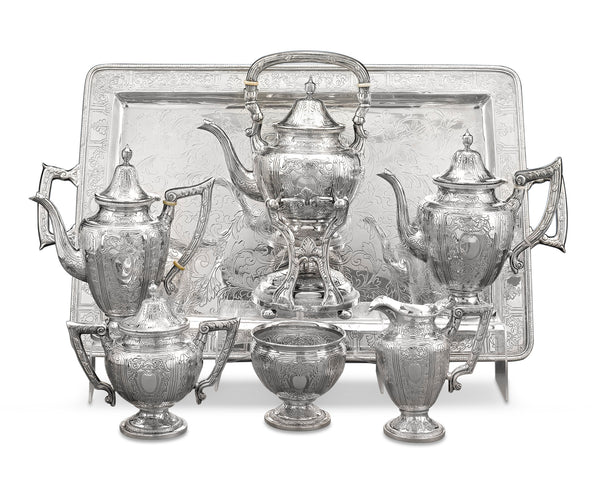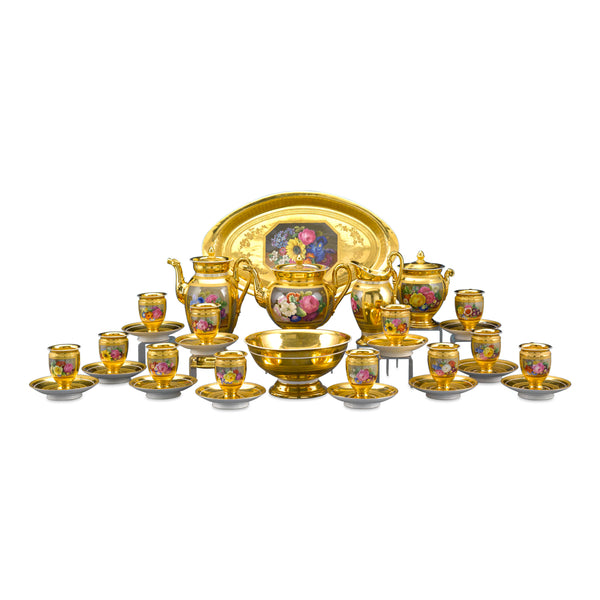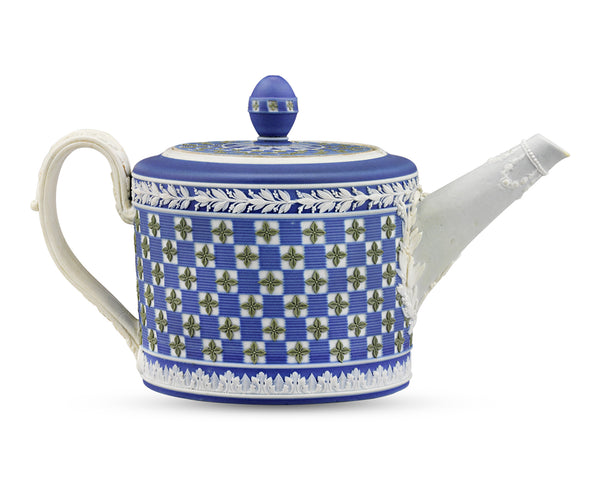
Tea bears a rich and complex global history, originating in ancient China nearly 5,000 years ago in the Yunan region during the Sheng Dynasty as a warm medicinal beverage. Lore has it that Emperor Shen Nung discovered tea when leaves blew into a pot of boiling water in 2732 B.C.E., enticing the ruler’s senses with a pleasant scent — changing the world forever. Uniquely, traditions involving tea as a beverage for healing and pleasure are found in almost every culture worldwide, from China to England, Russia to India. Ahead, a brief world history and some of M.S. Rau’s finest tea sets and accessories. Pinkies out!
AN ASIAN INNOVATION
In China, tea’s popularity grew rapidly from the 4th through the 8th century, evolving from a medicinal agent to an everyday refreshment. As tea plantations spread throughout China, tea leaves became expensive commodities, and tea merchants entered the wealthy elite. The Chinese Empire tightly controlled the cultivation of the crop, and a new fascination sprang up around tea culture. Now, elegant Chinese tea wares have become the banner of wealth and status. Tibetans were introduced to tea in China during the early 9th century. Tibet’s rocky, mountainous terrain made cultivating tea impossible, so it was imported from China via yak caravan in long expeditions that took an entire year to complete. Not only was this journey treacherous due to the dramatic landscape of the Himalayans, but tea thieves and pirates also threatened the Chinese-Tibetan tea trade. Two to three hundred tea yaks traversed the country daily to meet astronomical demands. Tea became so popular in Tibet. Compressed tea was used as a form of currency that could pay for almost anything in Tibetan society, including payment for workers and servants.

Likewise, Japan was introduced to tea in the 9th century by a Buddhist monk studying abroad in China. Tea became a central part of the Japanese monastery, with monks employing the newly cultivated beverage to stay awake and alert during prolonged meditations. By the early 14th century, tea drinking was popular throughout all levels of Japanese society, but its early monastic use permanently lent a spirituality to tea in the culture that directly influenced the Japanese Tea Ceremony. Also known as the Way of Tea, the Japanese Tea Ceremony was the practice of preparing and presenting matcha green tea. Unlike loose tea, matcha came in a powdered form and was a common activity for individuals who followed Zen Buddhism.
The advent of black tea can be traced back to the explosion of foreign trade with Europeans. Until the mid-17th century, China only cultivated green tea. Tea farmers invented a method of tea processing and preservation using fermentation, resulting in black tea, which kept its flavor and aroma longer, making it ideal for export.
GLOBAL TRADE AND THE EAST INDIA COMPANY
Portuguese and Dutch traders began importing tea seeds and other products into Europe from China in 1610, but England’s famous obsession with the steeped beverage did not start until half a century later. In 1662, King Charles II wed tea-loving Portuguese princess Catherine of Braganza, who introduced tea to the nation as part of her dowry — a chest of fine Chinese tea. The exotic treat’s popularity spread like wildfire through the British empire and Europe once Britain’s new queen began serving tea to her aristocratic friends in royal court.

The Dutch dominated the Asian tea trade until 1678, when Britain’s love of the drink exploded, compelling England to import tea and tea seeds directly commercially rather than deal with the Dutch. Seeking full control of trade and profits, the British Royal Family chartered the East India Company, granting it a monopoly on all Asian and East African trade. The East India Company quickly became the most powerful monopoly the world has ever known — and tea was its primary commodity. The company was given the right to acquire territory, coin money, keep armies and forts, punish lawbreakers, form foreign alliances, and even declare war. The East India Company remained the world's leading producer in the Atlantic tea trade until 1833, when the British Parliament declared its trade routes open to competition. Yet, the East India Company's lasting effects indeed changed the world regarding tea consumption. Tea prompted an entire global economy, and Hong Kong, Singapore, and India were claimed as British colonies that still retain strong cultural and political ties to the United Kingdom to this day.
THE RUSSIAN CONNECTION
Like their Western European neighbors, Russians are well-known for their love of tea drinking, which has played a significant role in Russian culture for some 400 years. And it’s no wonder: In Russia’s frigid climate, warming beverages like tea (and vodka) come in handy. Russians are experts in selecting and producing fine teas, which are not simply comforting quaffs but also a vital social activity backed by long-reaching cultural traditions. The warm drink quickly gained popularity in the Russian Empire in the 17th century after Imperial China presented Tzar Alexis with the gift of tea in 1618. Similar to the ancient Tibetan tea trade, China began exporting their cash crop throughout Russia via a camel caravan trade route. Spanning more than 11,000 miles, the treacherous tea route took almost two years to traverse by camelback. Russia’s thirst for tea was so insatiable that this trade route was routinely packed with 6,000 camels transporting 600 pounds of tea each for centuries. In the early 20th century, the famous Trans-Siberian Railway replaced the camel caravan, slashing the exorbitant transportation time from a year and a half to one week.

EUROPEAN LEGACY
For centuries, tea was an exotic imported luxury that only wealthy Europeans could afford to enjoy. Expensive tea prices made the beverage highly fashionable and created an atmosphere of elitism amongst tea drinkers; serving and elegantly drinking tea took skill and etiquette training that marked lofty social status, intellect, and superior breeding. In fact, from the 17th through the 19th century, many aristocratic and well-to-do European families commissioned paintings portraying the family drinking tea. “Afternoon tea” became a popular British institution in the 18th century thanks to Anna Russell, 7th Duchess of Bedford. Loathing the long gap between a light breakfast and a late evening meal, the Duchess instructed her maid to bring a pot of tea and light refreshments to her room to ease her hunger pangs. She soon began to invite friends to join her for afternoon tea, thus sparking a lasting trend of teatime. Though equally recognizable, British “high tea” is quite different. Though it may sound more elite, high tea is actually a 19th-century working-class custom served later — around 6:00 p.m. — consisting of a full dinner meal. Fish, meat, eggs, cheese, bread, butter, and cake are all served as staples of high tea in Britain. Surprisingly, high tea is considered a masculine affair while afternoon tea is more of a lady’s social diversion.

AMERICAN TEA TRADITIONS
As North America was colonized in the 17th and 18th centuries, European and English teatime traditions and rules of etiquette crossed the Atlantic. Colonists founded teahouses in their new North American communities, and elegant silver and other types of porcelain tea wares and accessories became exceedingly popular in the new cities of New York, Boston, and Philadelphia. By 1750, tea was the single largest and most valuable British commodity exported to the colonies. In an effort to capitalize on its American popularity, the British government levied a “tea tax” on colonists, gradually increasing the tax rate to 119%—more than doubling the initial wholesale cost of tea. As an act of defiance in the face of British greed, American ports refused to allow any dutiable goods ashore — namely, tea. This historic moment resulted in the famous Boston Tea Party, the British government's closure of Boston Harbor, and the arrival of British troops on American soil. Boycotting tea became an act of American patriotism from this moment on. This series of tea-centric events harkened to the beginning of the American Revolution and America's known preference for coffee! Despite the United States' ardor for the coffee bean, American culture still changed the tea industry in a big way. In 1904, a group of tea producers organized a tea pavilion at the St. Louis World’s Fair, offering cups of hot tea to all attendees. Unusually hot summer temperatures prompted the booth supervisors to pour piping-hot tea over ice, creating a quintessentially American way to imbibe tea — iced tea. Tea drinkers lined up to quench their summertime thirst with the frosty new innovation. Today, the U.S. guzzles almost 50 billion glasses of iced tea in a single year, accounting for more than 80% of all tea consumed in America.
Browse M.S. Rau's impressive selection of tea sets,accessories and other valuable antiques from around the world.
References:
“The Birthplace of Tea,” Coffee Tea Warehouse. Accessed January 7, 2020. http://www.coffeeteawarehouse.com/tea-history.html
“A History of Tea,” Peet’s Coffee. Accessed January 7, 2020. https://www.peets.com/learn/history-of-tea
“Russian Teatime Traditions,” Trip Savvy. Accessed January 7, 2020. https://www.tripsavvy.com/russian-teatime-traditions-1622500






